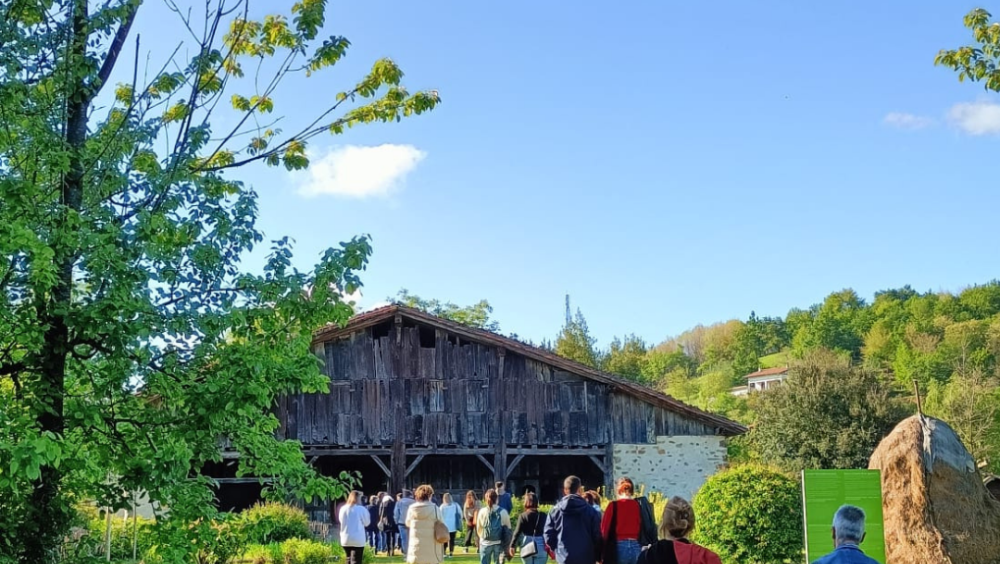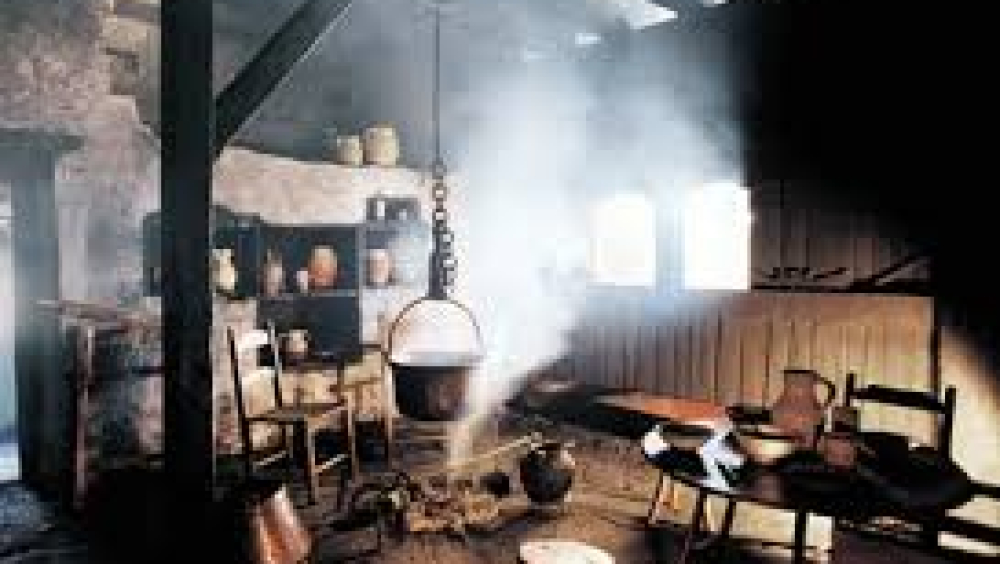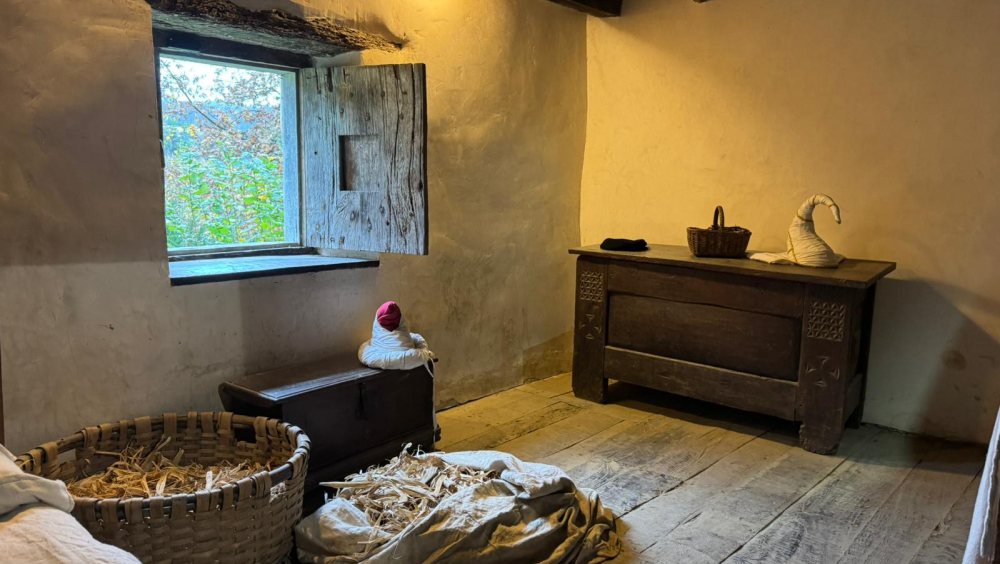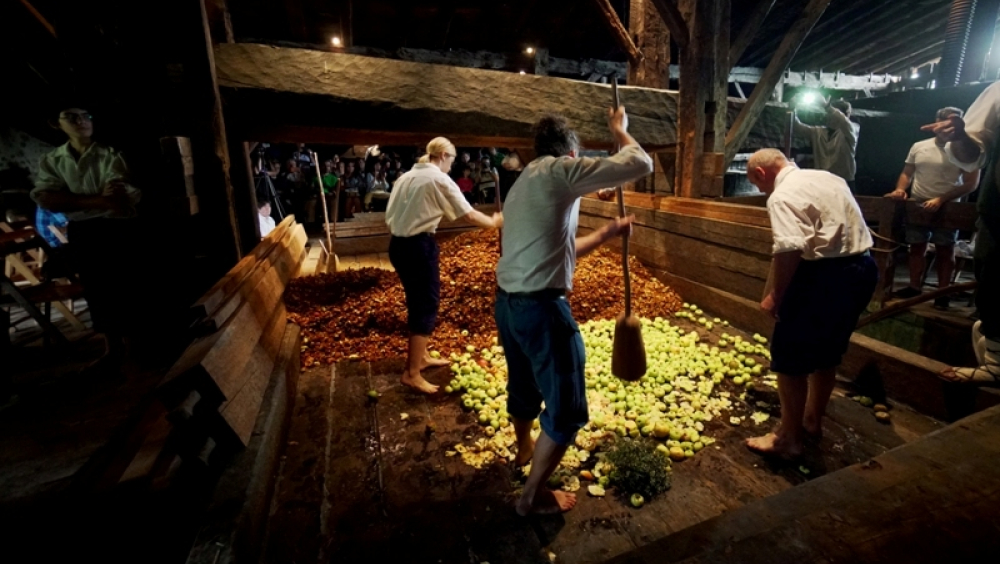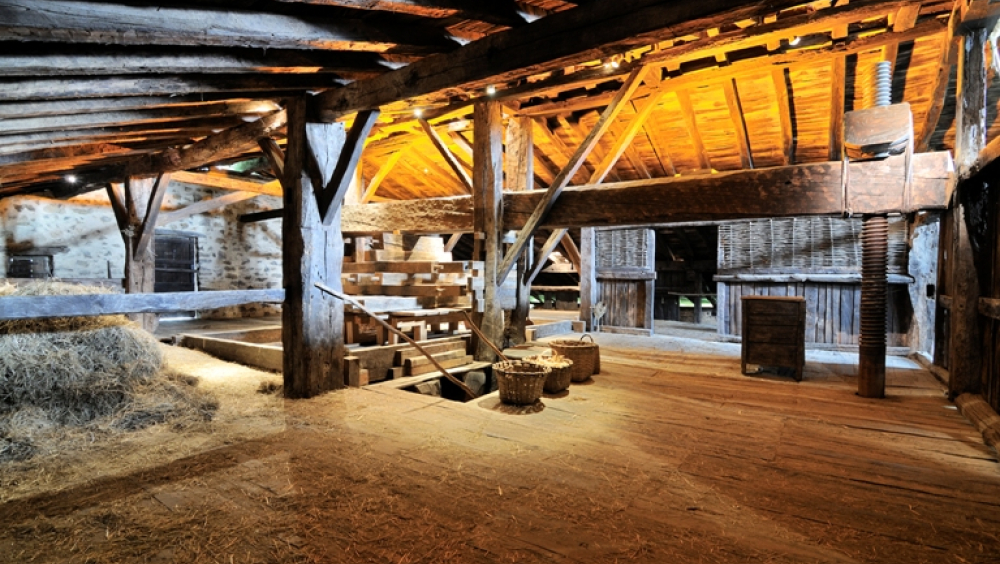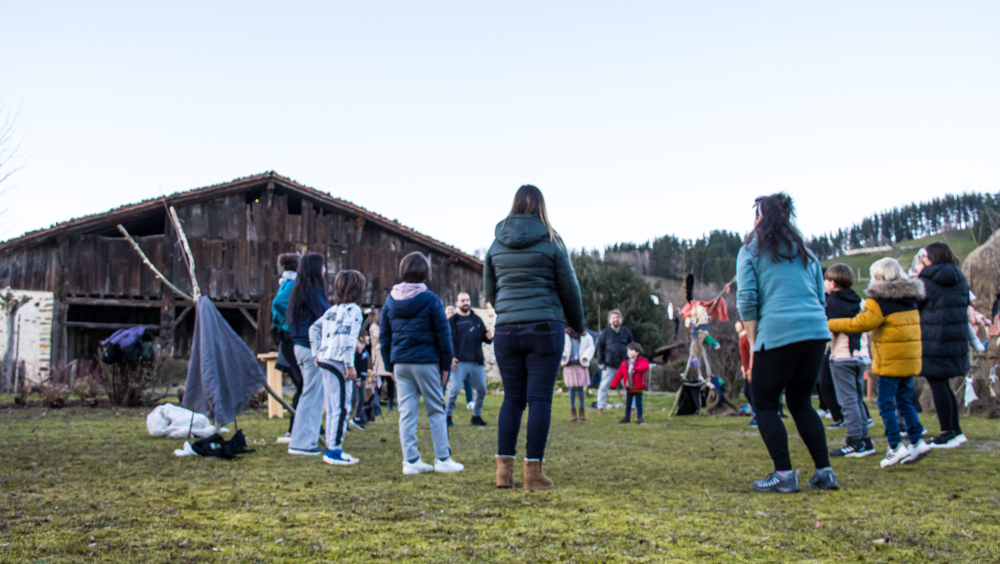OGIBIDEAK: CONTEMPORARY LEGACIES
The Igartubeiti Farmhouse is a place that hides and keeps an endless number of stories. For this occasion, we would like to tell you the story of Martintxo, the boy who lived in the Igartubeiti Farmhouse in the 17th century, when there was still no school in the village. Martintxo was unaware of the world beyond what his eyes could see from the farmhouse but what Martintxo did not know was that at school he would find a window to a world of knowledge.
He, his family and all those people who came after him left us a valuable material and immaterial legacy that we now preserve and transmit from the Igartubeiti Farmhouse Museum. In addition to being a magnificent example of medieval wooden architecture, Igartubeiti is known for preserving a large cider press that was used to make cider. All these details make it a building that not only represents local culture and identity, but also stands as a witness to a common and collective memory that most European countries share: a rural and traditional past that is slowly disappearing.
To tell all those stories, ways of life, trades, jobs, customs and traditions that await at Igartubeiti, what better than to bring the school to the Farmhouse-Museum, what Martintxo did not have the opportunity to experiment. In collaboration with the local school of Ezkio, in Ogibideak: contemporary legacies the Museum will use the architecture of the farmhouse as the main axis to generate new educational resources that will help the new generations think about how the ways of life, needs and decisions of the past influence our landscape and societies today.
Midday, the temperature is nice in Ezkio, a town in the interior of the region of Gipuzkoa. It is a beautiful day, but that is not noticeable in the grey darkness full of smoke in the kitchen of the Igartubeiti farmhouse. Kattalin, heiress of the Igartubeiti farmhouse, has just arrived from the stream that runs down the farm. The cauldron is ready on the fire. Soon Martintxo, his youngest son, will arrive from playing outside, telling stories, as always. Martintxo has also probably been hunting birds. Kattalin tells him to leave the poor little birds alone, they are singing, they are sweet and their singing is a delight to the ears… Domingo, his father, teases him but Martintxo didn't exactly come jumping for joy today, he came with his head down, entered the kitchen as if he wanted to tangle all the smoke on his head. Martintxo goes under his mother's skirt, and after drying his tears Kattalin ruffles his hair and caresses him.
- Mommy, what’s school? - Martintxo asks her.
- School... school... School is the world, Martintxo. - Kattalin answers.
- Mom, I don't want to go to the world. I'm fine in Igartubeiti.
Katalin stirs the food with the large wooden ladle that her mother gave her.
- But, Martintxo, the world will open new windows for you…There is only very little you can see from Igartubeiti, Martintxo. You can see almost nothing.
And at that moment, Domingo, comes into the kitchen. He coughs between the kitchen fumes, sits down on the bench and says:
- Martintxo, they're going to open a school in the Anduaga neighbourhood. You'll see, at school you'll get to know the world.
And Martintxo starts to cry again, saying no and no, that he doesn't want to go to school, that the world is too big and that he'll get lost.
- Dad, besides, there aren't any birds in the world like here in Igartubeiti.
Martintxo lived in Igartubeiti in the 17th century, when there was still no school. He spent his days helping his father take the cows from one place to another, drinking the apple juice that fell from the drain of the press, reluctantly tidying up the house, cooking in the dark kitchen with his mother and playing outside. His world was the farmhouse and its surroundings, so Martintxo was afraid of school, it was something unknown to him, but his mother and father made him understand that school was like opening a window to the whole world.
Currently, Kattalin’s Igartubeiti Farmhouse has become the Igartubeiti Farmhouse Museum, an active cultural space that transmits the cultural heritage of Basque society from a current perspective. A space that promotes a sustainable social transformation from an educational and social vision of cultural heritage.
The farmhouse of Igartubeiti is the main axis of the safeguarding and promoting material and immaterial heritage unique in the Basque Country, it acts as a symbol of a cultural heritage and also positions itself as a tractor for local development.
Igartubeiti is a cider press farmhouse. Inside, in the heart of the house, it hides the machinery used to obtain the juice from the apples to make the elixir of the Basque farmhouses, cider. It has functioned as a living space for large families and as a factory at the same time. The arrival of corn from the Americas at the end of the 16th century meant that the architecture of the farmhouse had to be transformed, creating a granary where corn could be shelled, different cereals stored, and other tasks such as farmhouse maintenance and domestic craftsmanship could be carried out. The house was a factory and a meeting point at the same time, it served as a social meeting point. In addition, the crafts, agriculture, gastronomy, architecture, beliefs and other practices and skills that inhabit the farmhouse are an important way of transmitting the history and traditions of the community.
Since 2023 the Igartubeiti Farmhouse Museum has been working with the local school of Ezkio, opening windows to the world as it happened to Martintxo, identifying the ways of life in the village's farmhouses, thus bringing together past, present and future. The project Ogibideak: contemporary legacies identifies the work and trades of Ezkio, a village of 467 inhabitants that until the mid-20th century was rooted in the agricultural sector and in the farmhouse as a habitable architecture and a workplace. Industrialisation and the lifestyles associated with it changed the pace, needs and customs of the population. This new lifestyle, coupled with profound changes, brought new opportunities. Today, the vast majority of the inhabitants make their living from industry, but the consequences of these transformations have been the loss of the knowledge, customs and trades that defined the rural environment and the fracturing of the intergenerational links.
In order to restore this intergenerational fracture and the loss of knowledge and trades, the Igartubeiti Farmhouse Museum’s Ogibideak: contemporary legacies aims to connect with today's society, with the essence of the farmhouse and its values starting from the future generations .To do so, the Museum is working on the compilation of the material and immaterial heritage of the village through the oral transmission of different generations of the community. Through the Igartubeiti farmhouse, restored according to traditional techniques, we now have access to medieval architecture. Today, the youngest visitors have the chance to learn first-hand about this revolutionary invention. To explain this phenomenon, we will bring Igartubeiti closer to what Martintxo did not yet know, the school. Based on this previous experience and in accordance with the European Heritage Days’ theme of 2025, we will create new educational resources based on the construction of the architectural system of the Igartubeiti farmhouse that will be inserted in the educational programme of the museum.
Starting from a rural framework, the Igartubeiti Farmhouse Museum will disseminate these new ways of rethinking the legacy to a plural society, with the objective that present and future generations think about how lifestyles and needs influence the environment, architecture and society.
The disappearance of traditional rural society is a phenomenon common to all Europe. Since the 19th century, the economic and social changes that transformed a large part of rural Europe marked our perception of the landscape and the way we inhabit and live in it.
Igartubeiti, as a museum of society, seeks to preserve and conserve those material and immaterial testimonies that are the basis of Basque tradition and identity. Ogibideak: contemporary legacies focuses on the disappearance of trades and knowledge of a concrete and local area but can act as a reflection of a phenomenon that is happening in all European societies that are part of our collective memory. All the countries that make up the Council of Europe have an Igartubeiti, a place where stories can be shared, where people can see themselves reflected, where they can look back and rethink the future.
The farmhouse is part of a legacy shared by many countries in southern Europe. It is a complex carpentry building with a large lever press in the centre that was used to produce cider. Used to make wine, oil or cider, these types of cider presses, which were used hundreds of years ago in different countries in southern Europe, are today seen as authentic witnesses of a shared past. Igartubeiti, as a vestige of medieval wooden architecture, is an example of the conservation, safeguarding and transmission of this medieval wooden architecture and of the ways of life of a society that is disappearing. For this reason, the Museum seeks and promotes the involvement of the community in preserving its heritage so that, through education and awareness-raising, society can take ownership of it, rethink it, reinterpret it and identify with it.
